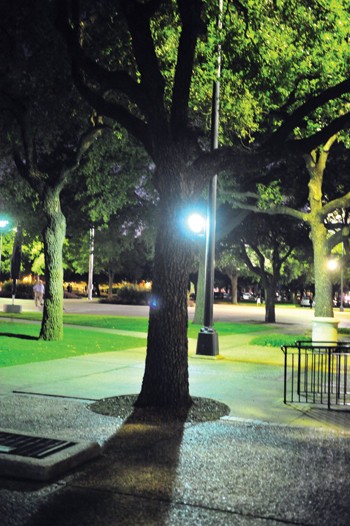
A night street light shines behind a tree near Umphree-Lee center. (Stuart Palley)
National Night Out at SMU ended with a survey of campus lighting by two groups made up of students, faculty and staff.
Participants observed exterior lighting in both the north and south side of campus to determine which areas were well lit and safe and which were not. Participants also observed the placement of emergency phones, or blue lights, and street safety.
All exterior lighting is designed to provide well-lit paths for students, faculty, staff and visitors to cross the campus safely, according to Director of Energy Management and Engineering Michael Paul.
“The lighting is designed to spread light out very far, and to do so as evenly as possible,” Paul said.
While the lighting is designed to spread out, Paul noted that the best exterior lighting situation is not as bright as a person might think.
According to Paul, if an area is too well-lit, it takes longer for the eye to adjust as it dilates from the bright light to the dark night. This adjustment period makes it unsafe to walk. Paul cited three areas of campus that have excessive lighting: the south side of Schlegel St., the areas around the new parking garage and the Laura Bush Promenade.
Paul also discussed areas of campus that need to improve lighting, such as Bishop Boulevard. In this case, Paul says the lighting fixtures need to be brought down below the canopy of tree leaves so that they can illuminate the sidewalk.
Paul says the goal is to have nice, consistent light at one level. To do this, Paul and a team take a tour of campus once a week to observe lighting.
SMU has undertaken several minor lighting projects, adding lights throughout campus and especially around areas that are frequented by older populations who need more lighting to see. These “special needs” projects include the area from McFarlin Auditorium to the Law School parking garage and the area around Umphrey Lee.
Questions arose during the lighting survey about the number of lighted paths on campus, as well as behavioral issues with students and personal safety.
Paul emphasized the importance of taking the best-lit path, even if it took longer. But Student Body Secretary Erika Briceno noted that many students wouldn’t take the longer route to get where they’re going.
She cited residents of the Kappa Alpha Theta and Delta Delta Delta houses. Going back and forth from Fondren Library, she pointed out that the residents have a straight shot through a dark street with little to no lighting. To take the well-lit path as suggested by Paul would mean going farther north and then traveling south. Briceno said most girls don’t do this because it doesn’t make sense.
Another issue involved the lighted crosswalk near the Dedman School of Law. The point was made that students are not pressing the button, which lights up the crosswalk. This means it is harder for drivers to see if a student is crossing the street.
Even if SMU officials decided to put more lighting in these areas, it may be a hard feat to accomplish. If the area is on a street governed by University Park, SMU has to go through its legal counsel and work with the city.
But Paul says his team is always willing to take a look at areas about which students, faculty and staff have concerns. SMU Police Chief Richard Shafer also stated that a person could report a light that is broken or not working by calling the dispatch at (214) 768-3333. Shafer said SMU PD can put in a request for it to be fixed.
Paul said these issues could be resolved without the addition or subtraction of lighting if a person stops and thinks. He said a person should always take the path that is the most lit, even when they aren’t on campus and even if it is the longer route, saying SMU provides enough paths of light to travel across campus safely.
He also advised people to take advantage of the Giddy Up Service, which runs seven days a week from 9 p.m. to 3 a.m.
“We’re going to put the resources in when there’s no alternative path,” Paul said.









